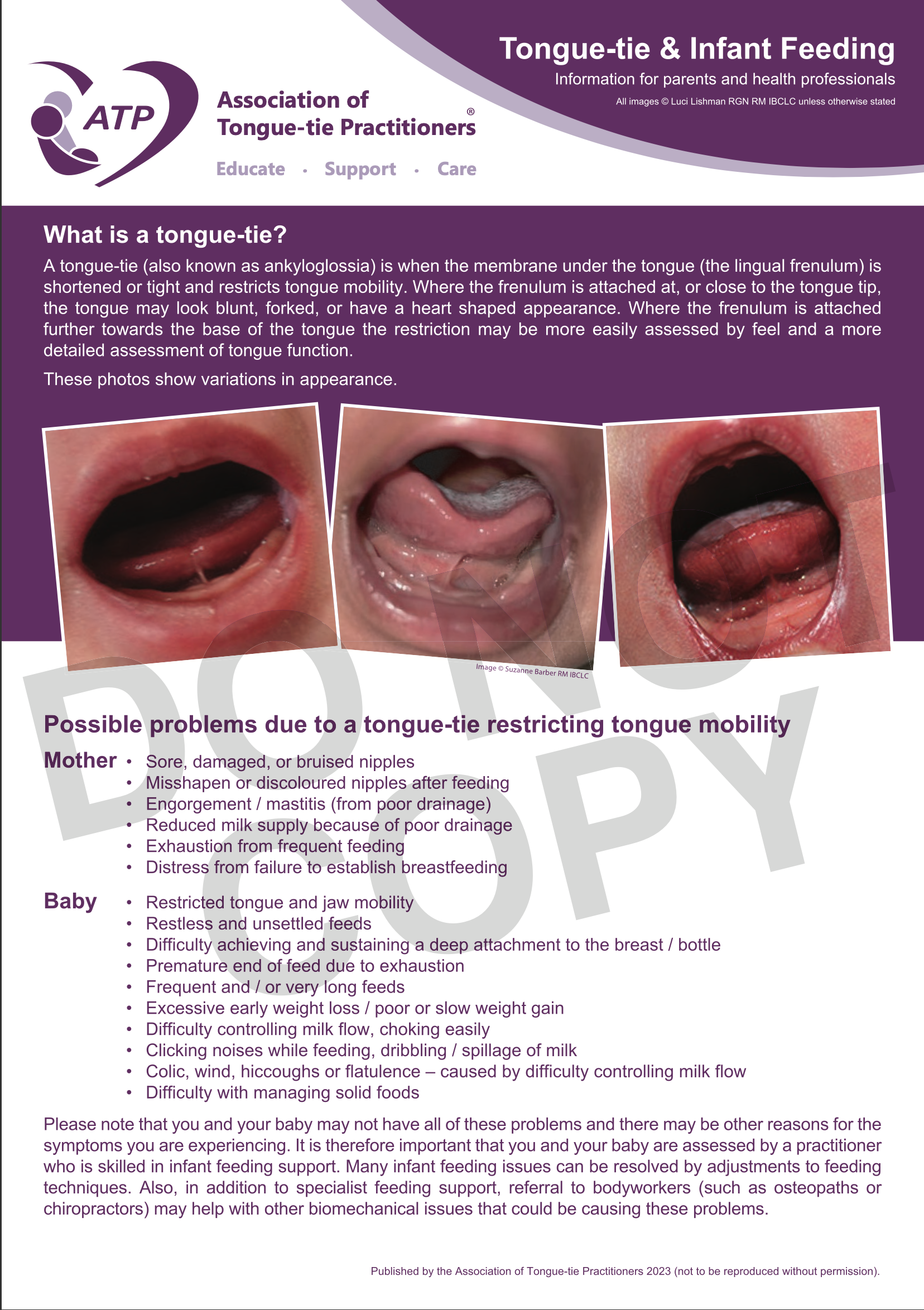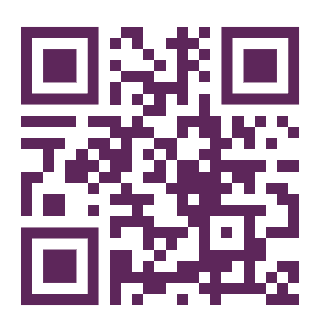INFORMATION & SUPPORT FOR THE PUBLIC
Please look on this page for more information on infant feeding support organisations, and information on the impact a tongue-tie may have on your baby, alongside some other important features.
Should you wish to access private or NHS support with advice for potential division of a restrictive tongue-tie, we have directories which show you local clinics and practitioners who are able to provide home visits or clinic attendance. Please see our 'Find a Practitioner' feature. This is inclusive of links to NHS provision. Healthcare professionals are encouraged to notify us if these are not wholly accurate with the correct details: NHS listings form.
From the 1st September 2019, all of the private practitioners listed in our ATP directory will be suitably registered health care professionals, who maintain adequate insurance and if appropriate, registration with the Care Quality Commission (England), The Regulation and Quality Improvement Authority (Northern Ireland) or Healthcare Improvement Scotland. Practitioners providing care in Wales are not required to currently register with Healthcare Inspectorate Wales.
ATP Conference 2025
ATP Conference 2025
The ATP committee are very excited to bring to you our first conference in 6 years! And its going to be epic!
We have the privilege of headlining Catherine Watson-Genna, IBCLC, world renowned author, researcher and an honorary member of the ATP joining us from New York; bringing to us a number of talks over the 2 day period.
Yvonne Le Fort, General Practitioner, IBCLC and the lead author of the ABM Position Statement on Ankyloglossia coming all the way from New Zealand to talk to us, and Jane Sibley who is the cleft palate specialist nurse at Oxford University Hospital Trust.
Bleeding Management Guidelines
BLEEDING MANAGEMENT GUIDELINESProlonged Bleeding Management Guidelines.
Applicable for both NHS and Private Healthcare.
Please also remember to complete the 'ATP Clinical Monitoring Form'
LINK: ATP Clinical Monitoring Form
Notify your regulatory body where appropriate (eg CQC Notifcation form)
Complaints Guidance for caregivers - FAQs
COMPLAINTS GUIDANCEComplaints guidance for caregivers
This guidance has been collated by the Association of Tongue-tie practitioners’ (ATP) Litigation and Complaints Group.
It is intended to support families through a difficult period, by providing some answers to frequently asked questions, alongside sugggesing a preferred process framework when you wish to raise a concern with your provider.
Find a Practitioner Near Me
FIND A PRACTITIONER NEAR MEFind a Tongue-tie Provider
Here is a directory of members who have chosen to register their services to this register. You can search by geographical area such as by town/county or by using a postcode. If you know the name of the provider you wish to contact you can also search by using the practitioners' name or business name.
By providing a database of locations and contact details for its members, it is important to note that the ATP does not endorse or regulate any individual service that is listed. The ATP also acknowledges there are members who are qualified regulated practitioners, who choose not to list their services.
However, we do require that those who do choose to list within our directory are registered health care professionals, insured and regulated for surgical procedures as required by law.
As we are not a regulatory body, we ask our members to confirm they are suitably regulated, insured and trained. The ATP do random ad-hoc checks of individual services. We would encourage parents/caregivers to verify this information when choosing their practitioner.
Gallery
TONGUE-TIE GALLERYTongue-tie Gallery
Here we have a growing collection of images relating to a tongue-tie restriction and / or the oral cavity.
These images have been donated as example images only and are not diagnostic of a tongue-tie restriction, which can only be assessed by a physical in-person tongue motility examination.
All tongue-ties (frenulums) are variations in normal anatomy and vary in appearance.
A picture does not diagnose a tongue-tie restriction.
Gallery Consent Form
IMAGES (for gallery) CONSENT FORMTongue-tie Gallery Consent Form
Please send us your tongue-tie photos! Pre and post division, unusual anatomy and healing wounds for consideration to be uploaded to our online gallery.
Photos are uploaded anonymously and all patient identifiable data is removed.
If you are a healthcare professional, please consider sharing this link with the families that you support so we can grow our collection.
Healthcare Professionals
HEALTHCARE PROFESSIONALS PAGEHealthcare Professionals page
Here we have brought you a page of information and suggestions relating to a tongue-tie restriction that you may feel is beneficial to your practice.
Infant Feeding Support
INFANT FEEDING SUPPORTInfant Feeding Support
The ATP recognise that ongoing support throughout your infant feeding journey is paramount.
Here is a link to some national infant feeding support organisations.
Join the Association of Tongue-tie Practitioners
JOIN OUR ATP MEMBERSHIPJoin our Membership!
We would love to have you join our membership! If you are interested, we have a number of options available:
- Full membership
- Affiliate membership
- Retired membership
- Student membership
LEAFLET: Care After Tongue-tie Release (FREE)
 LEAFLET DOWNLOAD
LEAFLET DOWNLOADLeaflet Resource:
"Care After a Tongue-tie Release"
FREE Download
LEAFLET: Tongue-tie and Infant Feeding
 LEAFLET DOWNLOAD
LEAFLET DOWNLOADLeaflet Resource
"Tongue-tie and Infant Feeding"
FREE Download
Manual Therapy and Infant Feeding
MANUAL THERAPYWhat is the role of manual therapy for helping babies with feeding difficulties?
There are several healthcare professions that use manual therapy as their modality for treating the human body. Manual therapy is the hands-on method of treating the body, rather than a drug-based approach. The therapist uses a variety of techniques to support the tissues and help return function to a normal level when there has been injury or changes to the areas involved.
Media News & Responses to Articles
MEDIA & ARTICLE RESPONSESMedia News and Resources to Articles
The ATP have collected some local and national media articles and collated them here for you to view.
We have also responded to some articles for you to view at your leisure.
NHS Directory Listing Form
NHS Directory RequestNHS Directory Listing Form
If you would like to list your NHS service in our ATP directory, please complete your request by completing the form attached to the button below.
There is no charge to list any NHS service, the service lead/manager is suggested to be best placed to complete this form.
*It is the responsibility of the service provider to check their listing regularly to ensure thier entry is current and correct. Please remember this directory is managed by a team of volunteers. If you need to make any amendments to your listing please complete the 'Directory Listing Amendment Form' below and ATP volunteers will respond when they are able.
Amendments to an NHS service can be arranged by completing the form on the following link:
LINK: Directory Listing Amendment Form
All services that need to report any adverse clinical incidents should report these following this link:
LINK: Clinical Reporting Form
Position Statements
POSITION STATEMENTSATP Position Statements
A position statement outlines a viewpoint on a specific topic.
Our current Position Statements include:
- Lip-tie (labial ties)
- Disruptive Wound Management
- Frenulotomy (surgical release of tongue-tie) in different age groups
Resources to Support your Feeding Journey
RESOURCES (Coming soon!)Coming Soon!
Shop
ATP SHOPATP Shop
Welcome to our shop!
Here you can buy your resources and merchandise. We also have some free resources for electronic download.
- Purchases are inclusive of UK p&p.
- If you are a member of the ATP-don't forget to use your password as your 'promo code' for a further discount.
Tongue-tie Training FAQs
TONGUE-TIE TRAINING FAQsTongue-tie Practical Training FAQ's
The Association of Tongue-tie Practitioners does not provide training in tongue-tie division. However, we receive lots of enquiries about training so here are the answers to some frequently asked questions.
"What is a Tongue-tie?"
TONGUE-TIE INFORMATIONWhat is a tongue-tie?
A tongue-tie (also known as Ankyloglossia) is caused by a short or tight membrane under the tongue (the lingual frenulum).
Click on the button below for further information on its definition, how it may affect your feeding journey, and treatment intervention options.
Social Media Support
Infant Tongue-tie UK Support Group for Parents and Caregivers
Join Facebook GroupFacebook support group for public access
ATP Infant tongue-tie Support Group for Healthcare Professionals and IBCLCs
Join Facebook GroupClosed facebook support group
The ATP is inclusive of all families and their supporting networks. We understand that not all families use the terms ‘breastfeeding’ or ‘mother’. We are working hard to ensure our publications and wider community message are in-line with this. For definition purposes the terms:
- ‘Parent’ is taken to mean any person with legal parental responsibility for the child.
- ‘Mother’-birthing parent
- ‘Tongue tie practitioner’: a healthcare professional who is trained in the division of a restrictive tongue-tie (frenulotomy)
- ‘Infant feeding’ refers to all methods of feeding inclusive of breastfeeding/chest-feeding/wet or dry nursing/ human milk feeding/ formula feeding or the introduction of solid foods.


